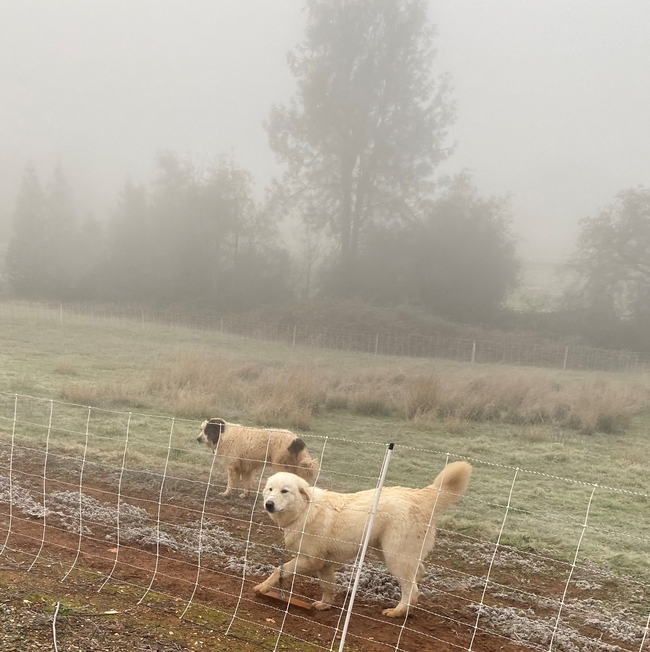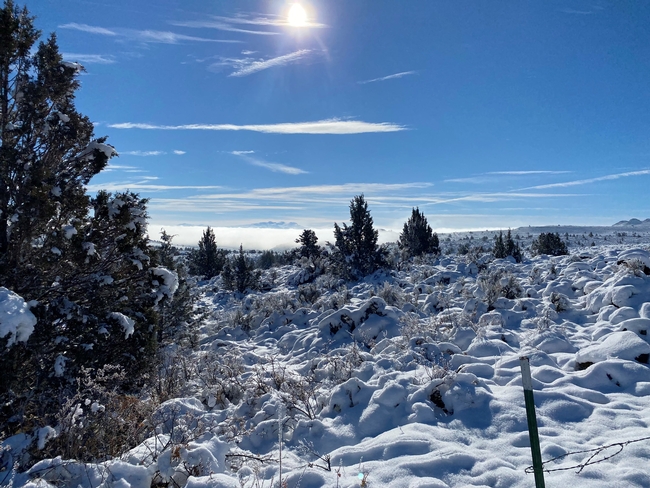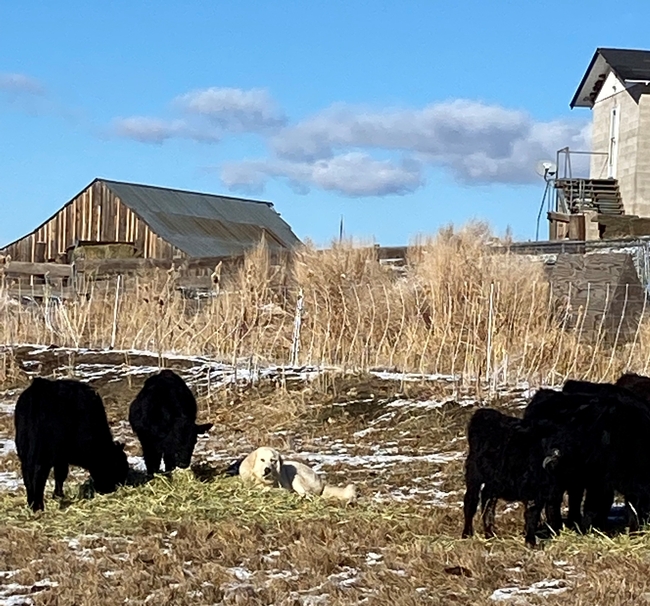On to the Next Phase
We've reached a new phase in our effort to learn how to bond a livestock guardian dog with cattle. As we described in previous blog posts, we are learning that we need to bond Sam, our 7-month old LGD puppy, with cattle – and vice versa. The cattle need to be as comfortable with Sam as he is with them – and so we'll be trying Sam in a new setting, with new cattle, after the first of the year.
The ranch we'd been collaborating with was planning to try Sam with a group of bred heifers they're keeping in close to their headquarters (they're due to start calving next month). The heifers, we were thinking, were more curious than older cows, which would hopefully help them accept Sam more readily. For the initial part of this new phase, we planned keep Sam fenced in an electronet paddock in the midst of the heifer field – the heifers would be fed and access water in close proximity, but the electric fence would prevent direct contact initially.
But then the ranch received about 10 inches of snow….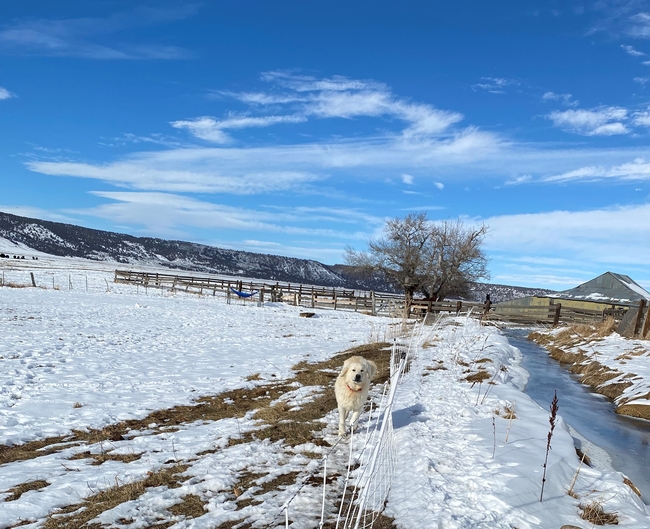
Snow is hard on electronet fencing – the weight knocked down sections of the fence, allowing the calves and Sam to get out into the larger pasture. On the plus side, Sam clearly demonstrated that he preferred being with the calves. While he'd come up to the ranch buildings when there was activity, he always returned to his calves. On the negative side, however, the ranch felt that our plan to keep Sam in electronet fencing in the heifer pasture was not workable with more snow in the forecast. On December 20, I traveled to Likely one last time and retrieved Sam. We'll move on to a new phase of the project!
I should note that Sam traveled well – the ranch trained him to walk on a lead and to be tied out, and he made the 4-hour trip in a dog crate without soiling the crate, crying, or barking.
For the short term, this new phase involves putting Sam with a handful of rams at our home place. He's also with our oldest and best dog, Bodie. We don't typically put a small pup with an older dog (as we want the pup to bond with livestock first). As a pup matures, however, an older dog can help reinforce the importance of respect for the livestock - Bodie has already corrected Sam several times.
While Sam continues to mature physically, he also continues to behave like a puppy on occasion – a puppy who weighs 80 pounds or more! In Likely, Sam demonstrated that he still liked to play with the orphan calves he was pastured with. This behavior included licking and sometimes gently biting their ears and faces, and bounding up to the calves if they were grazing at a distance. While the ranch corrected this behavior when observed, Sam couldn't be observed around the clock. Similarly, he was initially overly enthusiastic about the rams he's with now - so we're trying a tool that I've used on other young dogs that were exuberantly playful.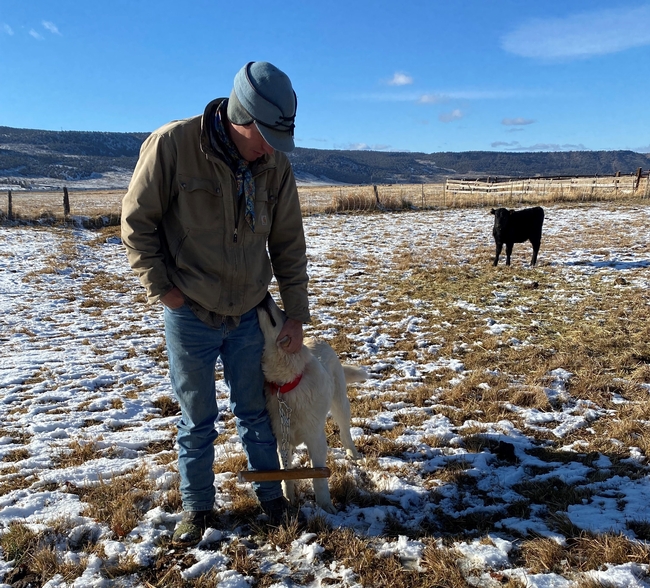
A dangle stick is a device that hangs from a dog's collar and makes running and jumping uncomfortable. Comprised of a piece of wood, short pipe, or weighted piece of PVC attached to a chain, the dangle stick hits a dog in the mid-leg area, making this activity uncomfortable. This discomfort, which is alleviated when the dog is walking calmly, corrects the unwanted behaviors – in other words, it makes the right behavior easy and the wrong behavior difficult. The dog can correct himself!
When we first attached the dangle stick to Sam's collar, he was annoyed by it – he chewed on the chain. Within several minutes, however, he accepted it and learned how to navigate the pasture with it. Over the last several days, I've watched Sam bound after the rams, only to have the stick knock against his legs. He stopped running and walked up to them calmly – just the effect we were looking for. Sam will wear the dangle stick for several weeks – and then we'll assess his behavior without it. If he reverts to his old puppy habit of running up to the livestock, we'll put it back on.
After the holidays, we'll place Sam on another cattle ranch here in the Sierra Foothills. This new ranch is a bit smaller (both in terms of acreage and livestock), but is having significant coyote issues during calving. We'll work with this new outfit to introduce Sam to the cattle and vice versa – with the hope that Sam and the cattle will eventually accept one another. While Sam still needs to prove himself, we hope that controlling his interaction with the cattle in a new operation will help further his training. I've observed similar challenges in bonding naïve sheep with LGDs – sheep that have been raised to be afraid of dogs don't immediately trust these big white dogs. In my experience, this is where the dog's submissive behaviors are so critical. While play behavior can be excused, aggressive or dominant behavior can't be. We'll be watching Sam for continued submissiveness as he moves into this new environment. We'll also be watching the cattle to see if they begin to accept this big white dog in their pasture. And as always, we'll be monitoring Sam's desire to stay with livestock. Stay tuned!